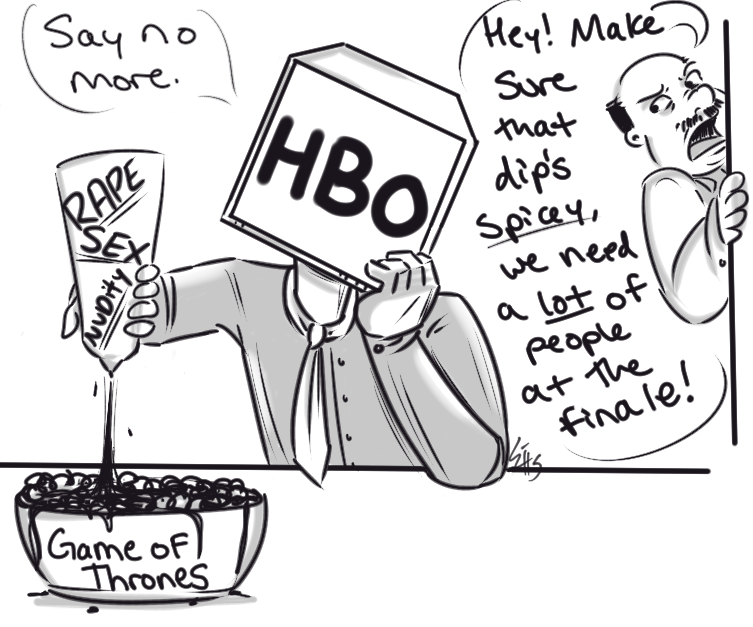“Game of Thrones” spoilers ahead:
I stopped watching “Game of Thrones” back at the beginning of season four. I gave the show a shot, and, initially, I enjoyed it. With “Game of Thrones,” it is best to delve into the series expecting the worst to happen. Anticipate that the characters you care about will soon meet their demise after you decide to care about them. The show is well known for its graphic violence, complex storylines, ambivalent characters and frank depictions of sex. The series revels in its all-around self-professed sensationalism — its dedication to doing anything and everything without shame.
And I expected the worst. The luridness of the show didn’t bother me on its own; however, within the context of the story’s progression, much of it felt unnecessary. “Game of Thrones” relentlessly hammers forth into the minds of its viewers the themes that its sensationalism strives to drive forward. While we’re meant to be surprised by the recurring violence, sex and combinations of the two, we eventually become desensitized to their being there in the first place. We know Westeros is a dangerous place. We know this from the primary plotlines. We don’t need to have rape regularly injected into the story as background noise to receive this particular message.
The highly controversial scene that ultimately caused me to step away from the series featured Jaime Lannister sexually assaulting his sister, Cersei — a scene that George R. R. Martin had intended as consensual in the books. When viewers questioned the decision to change the scene from reciprocal to nonconsensual, director Alex Graves and showrunner David Benioff refuted the idea that the scene in question was, in fact, sexual abuse. Despite that at one point in an interview, Graves referred to the act in question as “forced sex.” Despite that Benioff, in the video diary of the episode, said, “It becomes a really kind of horrifying scene … and you see that Cersei is resisting this. She’s saying no, and he’s forcing himself on her.”
What is rape then, if not “forced sex?” The showrunners of the series have repeatedly demonstrated a fundamental lack of understanding of what sexual assault is, in addition to continually demonstrating that they have neither the interest in nor the ability to adequately convey the impact sexual assault has on the victim. They care less about the impact rape has on the women in the show’s universe who are subjected to it and more about provoking audience reaction.
If this were an isolated incident, perhaps audiences would have found the scene more palatable. Yet, “Game of Thrones” is rife with these mishandled incidents of sexual violence.
Back in season three, we saw King Joffrey’s butchering of Ros, a character original to the show, who worked as a prostitute throughout the series before her death. Frequently during her run on the show, she seemed to exist solely to fulfill the male gaze quota for the week and occasionally help advance the plot. Her apparent worthlessness in the eyes of the showrunners is revealed through her relatively inconsequential death. The camera cuts to her skewered, lifeless body — scantily clad of course.
The choice to kill a character in a manner so sexually violent in order to assert a character’s evilness not only trivializes the presence of sexual violence in our society, but is also just bad writing. It is cheap and manipulative. The shock experienced by the audience is unearned.
Another more recent example exists in this past season with yet another main female character. In the episode “The Gift,” Ramsay Bolton rapes Sansa, the “puppy dog” the show loves to kick and one of the few remaining Starks. Again, a character the show has already established many, many times over as being evil, sadistic and inhuman rapes a woman to prove what we already know. At the risk of sounding redundant, this is gratuitous; this is lazy writing. Additionally, Sansa was never subjected to this in the books, and assuming that eventually she will end up in the place Martin initially planned for her, her rape is apparently negligible to her character’s arc.
As though the “torture” of Theon Greyjoy weren’t enough to demonstrate how horrible of a guy Ramsay is, the show feels it is necessary that yet another one of its female characters be sexually abused in order to titillate its audience.
In regard to the popular argument that things were like this for women in the time period of history George R. R. Martin claims to portray, this simply isn’t true. Historians have come forth to say that rather than representing a specific era in our own history, such as the Middle Ages, Martin pulls ideas from multiple periods. And though he extracts stories from history as inspiration for his plot developments, like with the War of the Roses, the backdrop for his epic tale most resembles that of typical environments of the fantasy genre. That Martin has adopted a distinctly historical setting in his writing does not hold up, as women weren’t abused so badly even back then. Many viewers groundlessly cite historical accuracy in these cases in order to protect their right to portray women as beaten-down, to add an element of “edginess” to their stories. Why must such tired and harmful tropes exist in this fictional world? It’s frightening that it is easier for us to imagine a world with dragons than it is to imagine a world where women aren’t regularly raped and threatened by men.
Besides this, the supposedly “historical” environment of Westeros specifically targets women in its depictions of sexual violence. “Game of Thrones” does not depict men being raped, not once. If we’re still adhering to the argument that the show reflects history, this rings distinctly false. Women wear a very specific target on their backs, and at this point, it seems as though the showrunners will mark the next victim of their treacherous environment when the other elements of the show begin to lull.
The differences between the show and the books began as small, yet noticeable, changes but have now grown in size so that the story itself is differentiated by its medium. This past season, book readers have lost their sense of direction, what with the changes made to Sansa’s storyline, the (supposed) elimination of Lady Stoneheart and the burning of Shireen Baratheon (an event Martin confirmed would be in later books). As the changes have grown, it seems evident that the more popular medium, television, has grown even more indiscriminate with how it treats its female characters.
My inability to continue to watch the show stems not from the fact that it includes rape, but that it uses rape merely as a ploy to generate shock in viewers. Within recent seasons, this last one in particular, many members of the audience have noted that the show seems to be retreading old territory, resorting to poor writing and jolting exploitation to keep watchers interested in the sometimes plodding action.
This is not to say that we should ban rape from being discussed in popular media. Rather, rape as a complicated, traumatizing act that affects people at the level of an epidemic should be addressed with the sensitivity and attention that it warrants. The exploitation of rape in “Game of Thrones” strips its strong, complex female characters of their agency — the series treats rape as a simple inevitability rather than as a horrendous act that men commit because society trains them to think of women’s bodies as their own. You can develop your female characters in more creative, less damaging ways—ways that don’t involve them being reduced to narrow archetypes.
“Game of Thrones” does not use rape as a means to address the systematic oppression women face in the universe and continue to face today, nor does it use it in a constructive way to explore the trauma sexually abused women are forced to confront. It does not use it to criticize the patriarchal customs we all still commonly fall prey to: it uses it as a gimmick. We deserve better.















